{: it}– But what do you ask your collaborators to say that you do as you please anyway? –
This was always the question that Maria Simoncini asked Dino Gavina, the subversive entrepreneur, as he liked to define himself, when he gathered his collaborators to ask them for their opinion. In fact, he did a lot or everything of his own mind, the "aesthetic worker", as the young Sgarbi defines him in the preface to the book "the adventure of design: Gavina", Jaca book. “ the industrialist who deals mainly with daily life, protagonist of the “domestic landscape” scene.
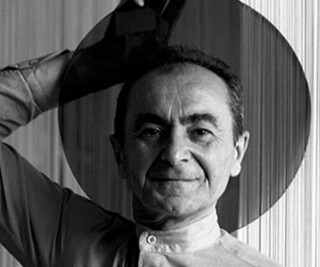
It makes me think that, when we talk about landscape, I don't know why the Marche is always involved in it.
Since I was a child I had to deal with Dino Gavina's furniture, indirectly. My godmother and friend of my older sister, ran, and still does, a beautiful furniture shop in the center of Ancona, where these strange objects were sold that aroused great curiosity in me.
I was ten years old and the table with crow's feet for example, ( Track by Meret Oppenheim, muse of Man Ray)
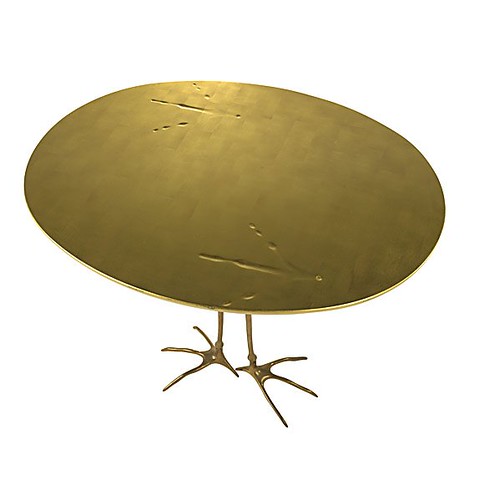
they transported me into the world of Walt Disney's "Fantasia", the film of which I had seen at that time, imagining that at any moment it would twist into a pirouette and start dancing.
It was the early seventies, freedom was in the air and the desecrating spirit, which always follows a period of extraordinary economic well-being, hovered everywhere, even in my Ancona. And I saw this in my family, in my older brothers who were all intent on breaking with tradition, starting with the furniture: my sister, on her first salary as an employee, completely changed her bedroom: on the beautiful 30s grit floor. XNUMX applies a red carpet, buys a strange wicker bed from her furniture maker friend, replaces the lamp with the Flos, that is, a steel wire on which a removable lamp slides. I looked at her in ecstasy. But it was this whole world of objects that attracted me, languages that told me they came from a proactive north, that is, from the rich Milan, the bearer of new artistic values; and while my grandmother/aunt took me to see Canova's tomb in the Frari church in Venice, the crazy young people of the family reflexively showed me a world made of ideas from which these strange multifaceted objects arose, some even equipped with fur, on display in the shop near my house.
I could never have guessed then that many of these pieces of furniture were not manufactured in distant Milan, but in my region, more precisely in Calcinelli, just behind Fano, and that the factory was called Simon International.
Simon International was born in 1968 from the entrepreneurial experiences of Gavina Spa, following the long collaboration with Maria Simoncini, from whom it takes its name and who is its managing director.
Meanwhile, Gavina spa is sold to Knoll with the intention of combining finance and ideas with Dino becoming responsible for the image of both companies, but after a short time he realizes how much all this is easier said than done and perhaps Simon International was born precisely out of this awareness. An operation resulting from a project “Ultrarational”, a term that expresses the desire to go beyond rationalism, while maintaining the rules of industrialization, and which reviews shapes and dimensions.
From here the rules of Italian design are also established which, according to Gavina, is nothing else an industrial project.
– If I have to do 50 welds to make a chair, this is not a design object. Design is an industrial project. Imagine a part of a car that needs to be assembled. – He explained to the architects who came to visit him. – The design is democratic.-
Seriality allows everyone to own that piece. And again: – Production is language, poetry. People today, who continue not to read books, are forced to read objects.-
Dino Gavina is the pure expression of the factory. Of ideas. Of ideas that can be realized by sharing other ideas. The collaboration with Carlo Scarpa – this delightful friend who I use without him knowing – is fruitful and long-standing,” he stated.
– Dino I made a wonderful table! – exclaimed an enthusiastic Carlo Scarpa – think it weighs 300 kg!-
– But you're crazy!!!!-
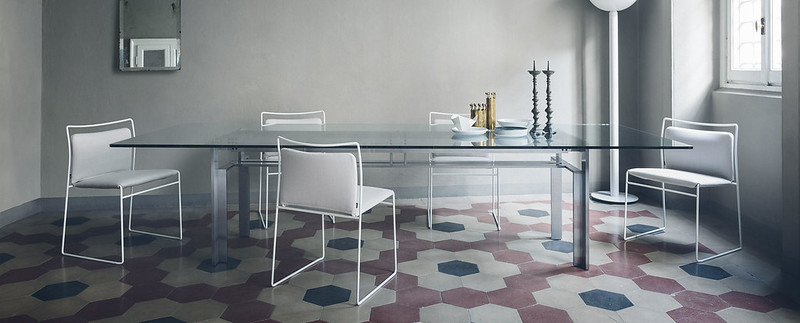
Americo Moretti, who worked as a sales clerk in the nineties, tells me what the environment at SIMON was like: "In those days around eighty workers worked in the factory and there were about fifteen of us in the offices alone. I was hired by Dino Gavina himself even though I came from the insurance industry.” His partner Maria Simoncini told him:
"But Dino he has no experience in this field!"
" Better! She has a purer and more receptive mind.”
Significant moments emerge from the history of Simon for the qualification of Italian designer furniture starting from the Seventies, and which always have to do with the industrial production method.
Alongside the operation Ultrarational there is Kazuhide Takahama, a Japanese architect who worked for a long time with SIMON and who also designed the factory. The famous chair by him Tulu which he performs in harmony and simultaneously with the equally famous table Doge and it was chosen by Carlo Scarpa precisely for that table.
Carlo Scarpa and Kazuhide Takahama thus became the center of gravity of the new company.
After the experience ofUltrarational in Dino Gavina's aesthetic laboratory the operation began Ultramobile. The poster is from 1971 and reads like this: “Your house / is inhabited by objects / the chairs, the tables / the armchairs the shelves / are for you / torpid unpredictable animals / which a custom / of forms / and cohabitation / has made opaque/static/lifeless/objects that are there/because they are there/ but we want every object to emerge/ at the end of the corridors/ in the center of the rooms/ like an apparition/ fully realizing/ the magic of its being/ the amazement/ that changes a presence into existence/ we do not want to abolish/ the naked rigorous proportion/ of the object that inhabits the space/ with the concrete strength of a thing/ made by man to serve man/ we have other goals: / your image / the wonder / that things exist / that you can touch them / inhabit them / become their accomplice / that you live with them / that a piece of furniture has / its own wonderful madness / the dark sensation / that a chair is living / like a rose.”
Do you understand what stuff? Poetry furniture or mutant furniture, those which, in addition to responding to a functional need, also respond to the need for a poetic presence in domestic environments. The Ultramobile artistic operation strengthens the partnership with artists of the caliber of Man Ray, Sebastian Matta, Meret Oppenheim. Who doesn't remember the mirror les grands trans – Parents? And the armchair MAgriTTA , Sebastian Matta's homage to Magritte, the one with the green apple and the bowler hat.
And the armchair Ron Ron from 1972, an armchair/animal with a tail?
The subversive Dino Gavina, as he presents himself in his business cards, is in continuous research and in continuous contact with many other artists: from Marcel Duchamp to Marcel Breuer and Lucio Fontana, with the Castiglioni brothers, Alberto Giacometti, Novello Finotti, Allen Jones, with architects Ignazio Gardella and Luigi Caccia Dominioni.
“Working with him was fun but also very challenging – Moretti continues – every day was different from the others”
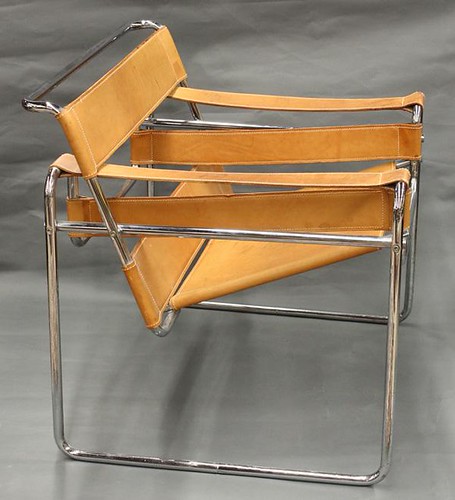
Another sign, another industrial adventure: the operation Metamobile of 1974, i.e. the production of a kit for the self-construction of simple and essential furniture, with guaranteed aesthetics. From the series: “the rich must be freed from kitsch for the rich and the poor equally, meta mobile proposes and adapts, alongside the works of famous designers, the anonymous project. “ A phenomenon that was ahead of its time and that ten years later would see the explosion of the television marketing of kitsch furniture at a low price.
The furniture is presented with two kits: 1) the one with boards to assemble and 2) the finished furniture.
Socially you can't go any further, he says. “True happiness is never having more than what you really need.” There are many models by Enzo Mari and Carlo Scarpa, studies that conclude with an exhibition at the Galleria Milano in '74 with a catalog of the Duchamp center " proposal for self-design".
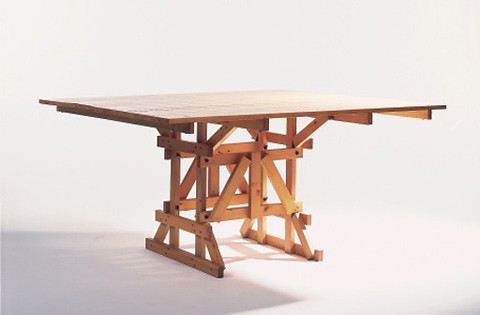
What Gavina underlines and explores is the relationship between industry and the art world. In Bologna she attended theater clubs where she found Damiani and Bolchi, she visited museums and art galleries continuously.
Dino Gavina's places, from his home in Foligno to Bologna, to Fano, Milan, Turin, Florence) were transformed into non-traditional containers of artistic initiatives.
In Rome he inaugurates a space in via Condotti where guests don't see his furniture, but his ready made by Marcel Duchamp who then states “it was the most beautiful exhibition I have ever had”.
In '69 the Duchamp Center in Bologna San Lazzaro. “With some resources instead of buying an apartment – says Gavina – I decided to set up the Duchamp centre. Although after a while I saw a few too many half socks going around. Mediocre people only produce trouble and are naturally never satisfied. If a person has quality, he is always on the sidelines, he doesn't work to make himself visible, he studies, meditates, works, so he must be sought out and tracked down."
How wonderful to read these passages, in an era where everyone tries to make themselves known, to emerge, he, the aesthetic industrialist, gives us lessons on how to recognize the one who has more to say than the others but does so without knowing it. And EHGombrich's first words in his "History of Art" come to mind: There is actually no such thing as art. Only artists exist: men who once traced the shapes of the bison as best they could with colored earth on the wall of a cave and today buy the colors and design the advertising posters, and over the centuries they did many other things."
Today, despite the official calls from the political world on the synergy between art and industry and the advantages that the latter can derive from it by deducting expenses from taxes, entrepreneurs like Dino Gavina have literally disappeared.
It makes me think that we have reached the true Platonic dualism between spirit and matter, despite the calls for unity from the new age currents of Hindu origin. It's not a good sign. Today's society pushes us to sectorize our work, because every activity is made more and more complex by an increasingly elephantine bureaucracy that is alienating us. And it delivers us directly to a new Middle Ages.
All that remains for me to remember with nostalgia is that world, made up of risks and artistic gambles and of men who knew how to dare, in an Italy that no longer exists but in which the Marche region was also a large part of it.{:}{:en }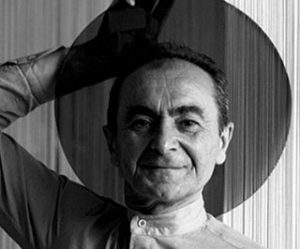
– Why do you ask a piece of advice to your working partners, if you do as you please? –
This was the question that Maria Simoncini often asked to Dino Gavina – the subversive entrepreneur, so he liked to be defined when he gathered his staff to ask for an opinion. In fact, he liked to do everything or almost everything as he pleased, the “aesthetic worker”, as the young Vittorio Sgarbi describes him in the preface to the book “L'avventura del Design: Gavina”, published by Jaca book: the industrialist that deals mainly with everyday life, the main character of the “home landscape”.
It makes me think that, when it comes to landscape, the Marche region is always involved, I don't know why. Since when I was a child I had to deal with Dino Gavina's furniture, indirectly. My godmother and friend of my older sister ran and still does a beautiful furniture store in the old town of Ancona, where they sold these strange objects that aroused great curiosity for me. I was ten years old and the table with hen paws (traces of Meret Oppenheim, inspiration for Man Ray) transported me into the world of Walt Disney's “Fantasia”, the movie I had seen in those days, I could imagine that from all of a sudden it could turn round in a pirouette starting to dance.
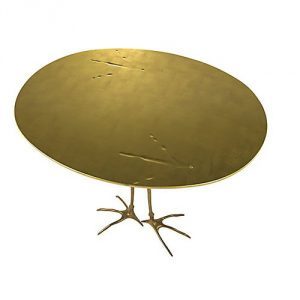
It was in the early Seventies and you could breathe freedom and desecration spirit, which always followed a period of extraordinary economic well-being, lurking in everywhere, even in my hometown Ancona. I could see this in my family, since my older brothers were all trying to break up with tradition, starting from the furniture. My sister, when she earned her first salary as an employee, completely changed her bedroom: on the beautiful granite floor of the Thirties she applied a red wall-to-wall-carpeting, bought a strange wicker bed from his fellow furniture maker, replaced the lampshade with a “Flos” (a steel wire on which a removable lamp runs). I looked up at her in ecstasy. It was these objects that attracted me, languages that came from a prepositive north, as I was told, from the rich Milan that was spreading new artistic values. While my grandma / aunt brought me to see the tomb of Canova in the Frari church in Venice, the young crazed in the family showed me a reflection of a world of ideas that came from these strange multifaceted objects, some even equipped with fur, in beautiful show in the nearest shop.
I could never imagine that many of these pieces of furniture were not manufactured in the far away Milan: they were manufactured in my region Marche instead, and more precisely in Calcinelli, very close to Fano, and the factory was called Simon International. The company Simon International was funded in 1968 by the entrepreneurial experience of Gavina Spa, following the long collaboration with Maria Simoncini, from which the name and its managing director. Gavina spa was later sold to Knoll with the intention of combining finance and ideas with Dino who becomes responsible for the image of both companies, but shortly afterwards he realizes how much difficult it was to combine and perhaps that is why Simon International was funded. An operation stemming from an “Ultra-rational” project, a term that expresses the will to go beyond rationalism, while maintaining the rules of industrialization, and which revises shapes and dimensions. From here the rules of Italian design get laid down, which, according to Gavina, is nothing more than an industrial project.
– If 50 welds need to be made to manufacture a chair, then this is not a design object anymore. Design is an industrial project. Imagine a piece of a car that has to be assembled. He explained to the architects who were visiting him. – Design is democratic. – The seriality allows everyone to own that piece. And again: – Production is language, poetry. People today, who hardly ever read books, are forced to read the objects. –
Dino Gavina is the pure expression of the factory. Of ideas. Ideas that can become real only when shared with other ideas. It is profitable and long the collaboration with Carlo Scarpa – this delightful friend I use without him knowing it – he asserted.
– Dino, I made a wonderful table! – exclaimed an enthusiastic Carlo Scarpa – its weight is 300 kg!
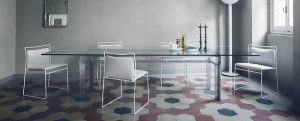
– You must definitely be crazy !!!! –
Americo Moretti, who worked as a salesman in the Nineties, tells me how the work environment was at SIMON: “At that time around 80 workers were working in the factory, and only in the offices we were fifteen. I was hired by Dino Gavina in person, even though I came from the insurance field. […] Her working partner Maria Simoncini told him: “Dino, he has no experience in this field!” and he replied “This is much better! He has a cleaner and more receptive mind.”
From Simon's history emerges significant moments in the development of Italian design furniture from the Seventies, and they always have to deal with the industrial production method. Next to the Ultra-rational is Kazuhide Takahama, a Japanese architect who will work with SIMON for a long time and will also design the factory. The famous Tulu chair was designed by Takahama and developed in harmony and at the same time as the famous Doge table, and Carlo Scarpa chose the chair for that table. Carlo Scarpa and Kazuhide Takahama thus became the center of gravity of the new company.
After the extraordinary experience of Ultra-rational in Dino Gavina's aesthetic laboratory, he moved to the Ultra-furniture operation. The manifesto was published in 1971: “Your home / is inhabited by objects / chairs tables / armchairs shelves / are for you / unpredictable animals / that familiarity / of shapes / and cohabitation / rendered opaque / static / lifeless / objects that are there / because we want them / but we want every object to emerge / into the corridors / center of the rooms / as an apparition / realizing the full / magic of its being / the amazement / changing a presence in existence / we do not want to abolish the naked rigorous proportion of the object that inhabits space / with the concrete force of a thing / made by man to serve man / we have other goals: / your image / wonder / things that exist / that you can touch them / live them / make them accomplice / that you live with them / that a furniture possesses / its own madness / marvelous / the dark feeling / that a chair is living – [full of life] / like a rose.”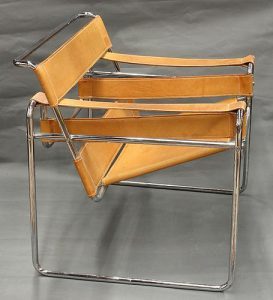
Great stuff, indeed. The furniture made of poetry or mutant furniture, those that in addition to responding to a functional need, also respond to the need for a poetic presence at home. Ultra-furniture's artwork strengthens the partnership with artists such as Man Ray, Sebastian Matta, Meret Oppenheim. Who does not remember the mirror “les grands trans-Parents?” and the “MAgriTTA” armchair, Sebastian Matta's homage to Magritte, the one with the green apple and the bowler hat. And Ron Ron's armchair of 1972, an armchair / animal fitted with tail?
The subversive Dino Gavina, that is how he liked to be introduced, is constantly searching and in constant contact with many other artists: Marcel Duchamp and Marcel Breuer and Lucio Fontana, with brothers Castiglioni, Alberto Giacometti, Novello Finotti, Allen Jones, with architects Ignazio Gardella and Luigi Caccia Dominioni.
“Working with him was amusing but also very challenging,” Moretti says, “every day was different from the others”.
Another sign, another industrial adventure: the Meta-furniture operation in 1974, or the production of a kit for the manufacturing of poor and essential furniture – aesthetics guaranteed. Of the series: “Rich people should get rid of the rich's kitsch and the poor should do the same as well, Meta-furniture proposals and adapts, alongside the works of famous designers, the anonymous project.” A phenomenon that anticipates the times and ten years later there will be the explosion of the TV commercialization of the kitsch furniture at a low price.
There are furniture with two kits: 1) one with tables to compose and 2) finished furniture.
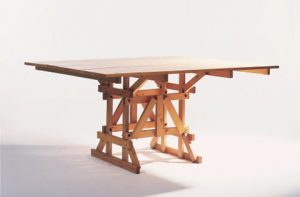
Socially, one cannot go any further, he says. “True happiness is to have nothing more than what you really need.” There are many models of Enzo Mari and Carlo Scarpa, which concludes with an exhibition at the Galleria in Milan in 1974 with a catalog of the Duchamp center “proposal for car design”.
What Gavina emphasizes and develops is the relationship between industry and the Arts. In Bologna he attended the theatrical circles where he found Damiani and Bolchi, visiting museums and art galleries continuously.
The places of Dino Gavina, from his house in Foligno, Bologna, Fano, Milan, Turin, Florence turned into non-traditional containers of artistic happenings.
In Rome he opens an area in Via Condotti where guests do not see his furniture, but Marcel Duchamp's “ready made”, which then says that “it was the most beautiful showroom I ever had”.
In 1969 it was officially formed the Duchamp Center in Bologna San Lazzaro. “With some resources instead of buying an apartment – says Gavina – I decided to set up the Duchamp center. Although after a while, I could see too many bad artists. The mediocre people produce only problems and of course, they are never satisfied. If a person has qualities that are always apart, he does not commercialize to show, he studies instead, meditates, works: so he has to be researched and found”.
What a surprise to read these words, in an era where everyone is trying to show off and get acquainted, to emerge, the aesthetic industrialist, gives us a lesson on how to recognize the one who has more to say than the others but does not know it. And I remember the first words of EH Gombrich in his “History of Art:” There really is not a thing called Art. There are only artists: men who once painted the earth to the best of the bison shapes on the wall of a cave , and today they buy the colors and draw advertising posters, and in the course of the centuries they did several other things”.
Today, despite the official calls from the political world on the synergy between Arts and industry and the benefits that it can take from the tax deduction, entrepreneurs such as Dino Gavina have literally disappeared.
It is to my mind that we have come to true platonic dualism between spirit and matter, despite the recall of unity from the New Age of Hindu origin. It's not a good sign. Today's society drives us to segment our work, because every activity is increasingly complicated by an increasingly elephant bureaucracy that is alienating us. And it sends us directly to a new Middle Ages.
All I have to do is remember those times with nostalgia, made of risk and artistic dangers and of men who knew how to dare: the Italian country that no longer exists, but in those times, the Marche region has played a major character indeed.
{:}

